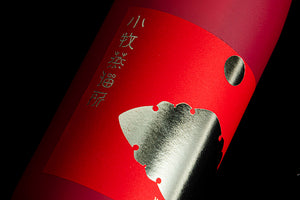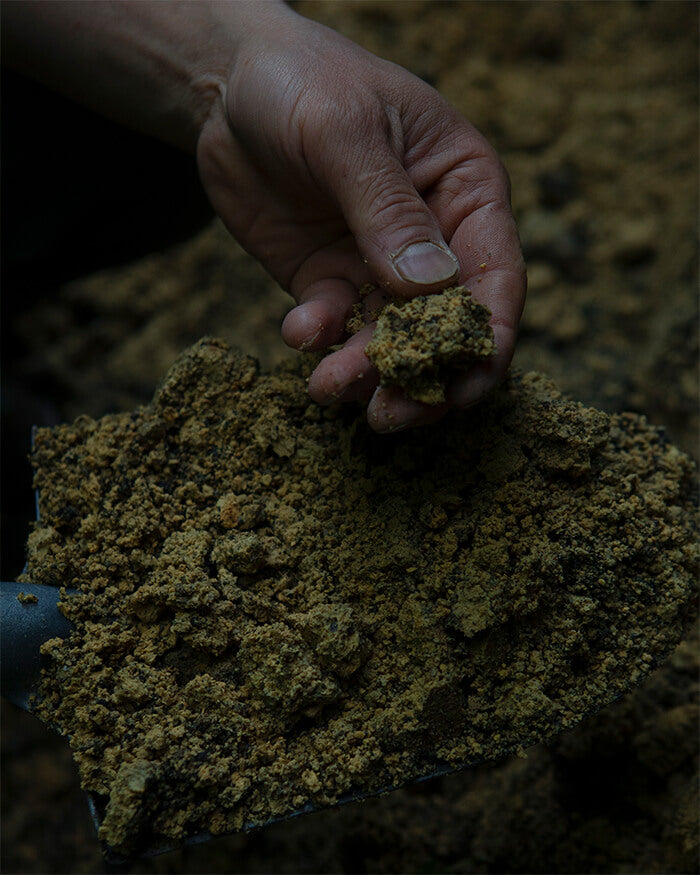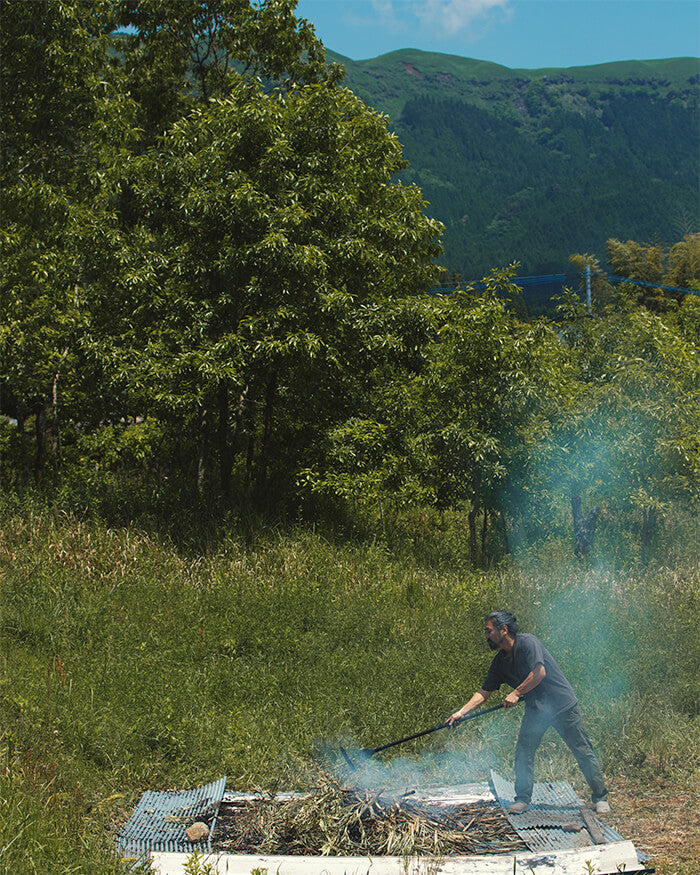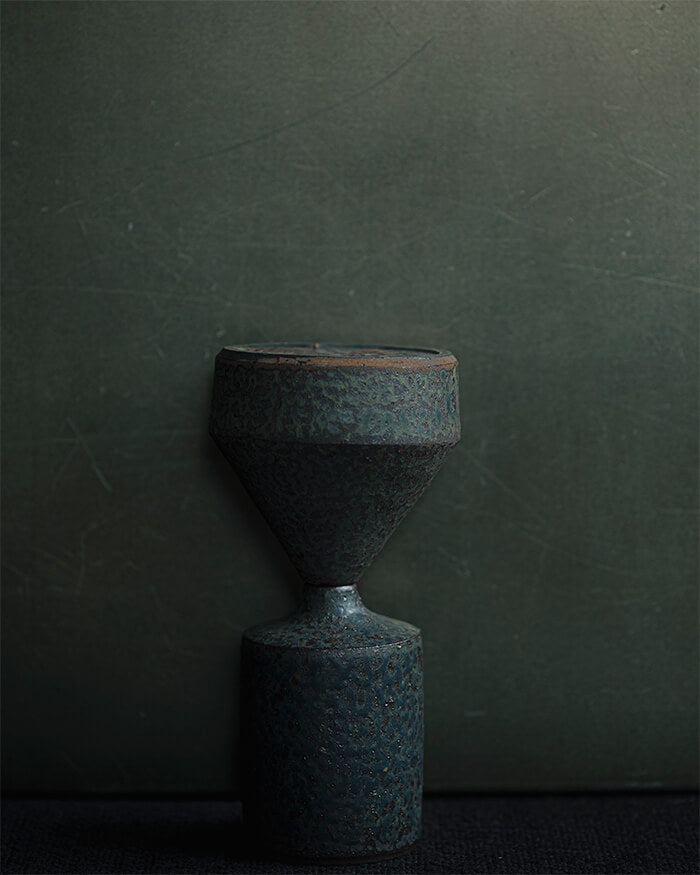
COVERCHORD FEATURE
FUTOSHI YAMASHITA
Vessels of Aso
Futoshi Yamashita’s ceramics embody the power of nature through meticulous craftsmanship
We visit his workshop in Aso to learn how his pottery is created
6月17日 (土) 発売
Futoshi Yamashita creates exquisite ceramic pieces by harnessing the materials sourced from the abundant nature of the Aso region, located in the eastern part of Kumamoto prefecture. The area is famous for its active volcano and large caldera, from which many of the materials he uses derive, including lava, volcanic ash, soil, clay, and water. His pottery encapsulates the robustness of the natural world and the delicate beauty achieved through refined craftsmanship.
His vessels exhibit a harmonious yet powerful blend of colors—white, yellow, red, indigo, olive, and black—achieved through his clay blends. Intricate crack patterns and lustrous, starry motifs woven by lava and volcanic ash are some characteristics of his works. The volcanic soil's distinct roughness adds a primitive texture, enriching the tactile experience.
Yamashita’s pottery is versatile, complementing various dining experiences, be it traditional Japanese or international cuisine. It transcends the boundaries of time and style, serving as sophisticated interior decor that enriches both modern and traditional living spaces.
To gain insight into the process behind these remarkable creations, we embarked on a journey to the Aso Bougama kiln, nestled in the scenic region of Aso.
There, we discovered Yamashita's unwavering reverence and gratitude toward the nurturing power of nature. His profound connection with the natural world is continually embodied in his artwork, a testament to his artistic vision and dedication.
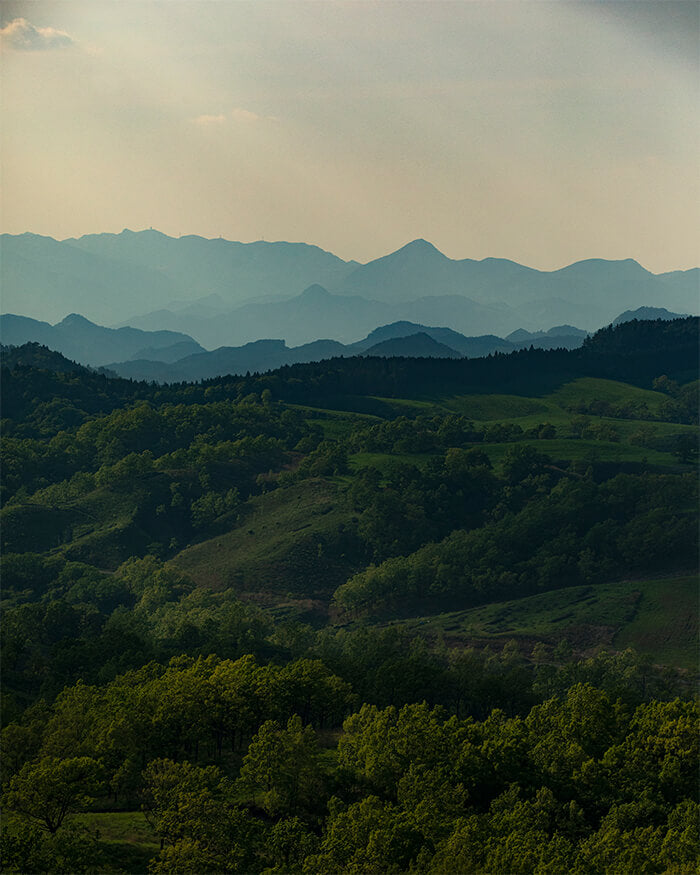
Futoshi Yamashita and the Aso region
Located in Kyushu, the Aso area boasts a magnificent landscape housing one of the world's largest calderas with a circumference of over 100 kilometers. Large volcanic eruptions between 270,000 and 90,000 years ago caused the underground magma chambers to empty and the land to collapse, forming the unique topography that can be seen today.
Born in 1973 in Fukuoka Prefecture, Yamashita developed a strong connection to Aso from an early age. Accompanied by his parents, he would frequently visit this special place that held great significance for his father, who enjoyed working in the fields as a change of pace from his usual routine.
Yamashita established his Aso Bougama kiln in 2003, in the same place where he had built a cabin with wood he had cut down himself as a youth.
Yamashita’s path to becoming a potter was not completely straightforward.
As a young man, he embarked on hitchhiking adventures through Southeast Asia and Europe, searching for his life's purpose. Fascinated by creating things, Yamashita dabbled in junk art using collected items and crafted bead accessories in Thailand which he sold in London. It was during this time that a single remark from a local person had a profound impact on his life.
"Why are you, a Japanese person, making Thai things?"
This question struck Yamashita deeply. He realized that despite being Japanese, he knew very little about his own country. He returned to Japan and began exploring various traditional crafts in Kyushu, his hometown region,and it was then that he discovered a style of pottery called Koishiwara-yaki at a workshop in Fukuoka Prefecture. A ceramic clock made using this method caught his eye and he felt a sense of revelation that his life had been leading up to this moment.
Yamashita apprenticed under the master potter Yoshiteru Kumagae, who specialized in Koishiwara-yaki, learning the fundamentals of pottery and honing his skills.
After completing four years of training, Yamashita returned to the Aso region. While traversing every corner of Mount Aso, he realized that the caldera itself resembled a vessel. This realization and his existing connection to the area led him to relocate there.
Yamashita decided that if he were to pursue his own pottery, he wanted to convey the essence of Aso's nature through his creations. He chose to discard everything beyond the foundational techniques he had learned, freeing himself from the constraints of traditional methods.
Now, after 20 years since establishing his kiln, Yamashita continues to resonate with the nature of the area, considering it his lifelong workplace.
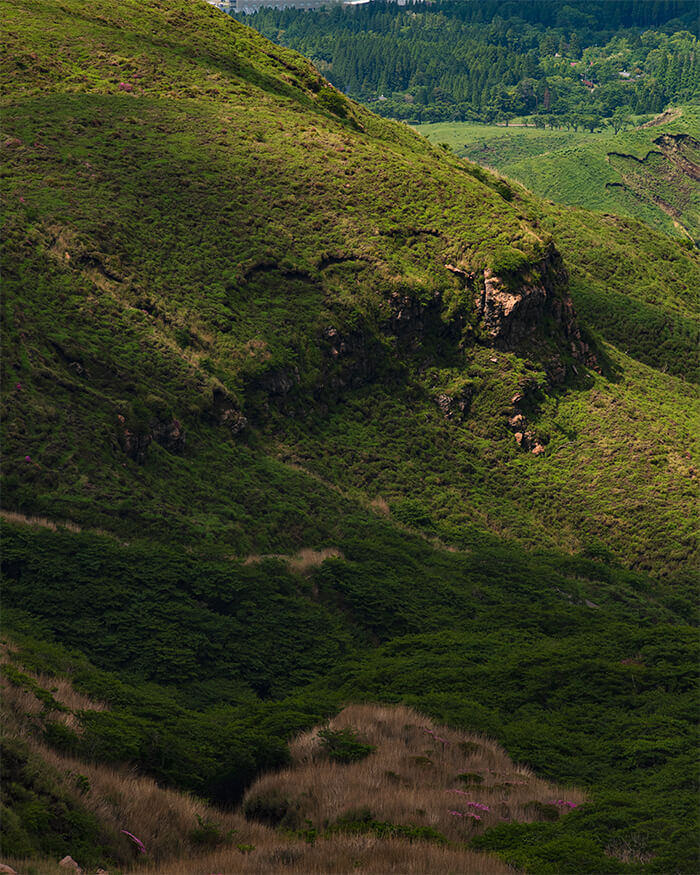
To discover the unknown
Yamashita emphasizes the importance of conveying the grandeur of Aso itself. He views his creations as tools for this purpose, believing that his role is simply to accentuate the power and characteristics of the materials. This perspective is akin to a chef drawing out the flavors of ingredients during cooking.
Since the base materials play a vital role in his work, Yamashita’s pottery-making process begins with him personally venturing into the mountains to source the materials with his hands.
The clay used as the base is a volcanic soil known for its unique property of purifying water. The glaze materials consist of minerals such as ash from plants like bamboo and Chinese silver grass, volcanic ash, and lava. Volcanic ash exhibits a range of different colors and textures depending on their age.
Heading into the mountains near his kiln to gather raw clay.

Yamashita has dedicated himself to refining, shaping, and firing the materials he sources. He becomes deeply immersed in the emergence of various colors through their combinations and rearrangements.
Due to the natural origins of the materials, it is impossible to create identical pieces. Once the formulated glaze runs out, the same result cannot be reproduced, so each day becomes a continuous encounter with the unknown. Yamashita has experienced countless failures along the way. However, he is able to view these failures as new discoveries and genuinely enjoys the process of progress and setbacks.
"I continue doing this because I want to see things that are unknown to me, things I have never seen before," he says. While the created pieces may change, this underlying reason for creating remains steadfast and unwavering.
Burning plants such as bamboo and Chinese silver grass to create his unique ash glaze.


Reverence for nature
Embedded in Yamashita's mindset lies a profound respect for nature, originating from animism—the belief that every entity, be it living or inanimate, harbors a spirit or soul. "As long as I am using clay, I cannot forget to express my gratitude to the gods."
Mount Aso, with its five peaks, has been revered as a place of worship since ancient times. According to legend, there were once 37 temples for monks and 51 hermitages for mountain ascetics on the mountainside with over 300 practicing monks at any given time. The location of Yamashita's first kiln, the Aso Bougama, was also said to be a sacred site of Shugendo, an ascetic mountain tradition, where the temples for monks were once built.
Yamashita feels a deep connection to the shrines and rocks of the area, where the prayers and traces of past generations remain.
Every morning he shows gratitude to the gods by visiting his Shinto alter and the shrines in his workshop, and takes breaks from work by immersing himself in the mountains.
At times, he travels as far as Oita Prefecture to visit sacred rocks that are believed to be a dwelling place of gods, and creates clay sculptures modeled after them. It is as though Yamashita incorporates nature within himself through these acts, resembling a sacred ritual.
Similar to the practices of the practicing monks in the past, Yamashita immerses himself in contemplation and engages in dialogue with nature in the tranquil mountains.
He approaches the land with a grateful attitude and shapes the clay with sincerity and refined craftsmanship. The relationship between them, where they mutually depend on and connect with each other, is truly beautiful.


FUTOSHI YAMASHITA
1973 Born in Fukuoka.
1995-1997 Travels through Asia, Europe and Japan.
1997-2001 Studies Koishiwara-yaki pottery.
2002 Founded Aso Bougama kiln, where he continues to create today.
Instagram_@futoshiyamashita
6月17日 (土) 発売
FUTOSHI YAMASHITA
Vessels of Aso
Futoshi Yamashita’s solo exhibition will be held at ROOTS to BRANCHES from Saturday, June 10th to Sunday, June 18th. The beauty of these pieces cannot be conveyed on screen, so please come by and take a look if you’re in the area.
FUTOSHI YAMASHITA
Vessels of Aso
Saturday, June 10th - Sunday June 18th / 11:00 – 19:00
ROOTS to BRANCHES
Aobadai 1-15-9, Meguro, Tokyo
Web: roots-to-branches.jp














